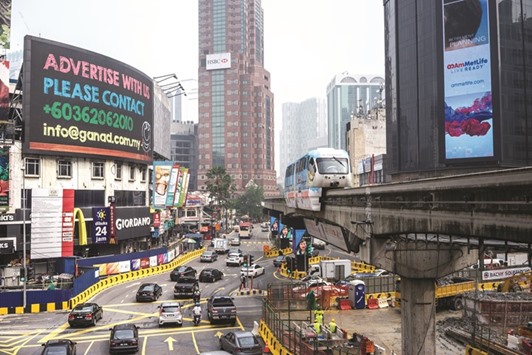The financier of a subway in Malaysia’s capital is seeking to tap the Islamic bond market for the second time this year after domestic borrowing costs fell to a three-year low.
DanaInfra Nasional Bhd plans to offer 2bn ringgit ($482mn) of government-guaranteed Islamic bonds after selling 4.5bn ringgit of sukuk in April, people familiar with the matter said. The proceeds will be used to help finance construction of the nation’s mass rail transit system, part of Prime Minister Najib Razak’s $444bn development programme. The company sold 10-year Shariah-compliant notes to yield 4.29% in April and the debt yielded 4.09% when it last traded on August 25, data compiled by Bloomberg show.
Malaysia’s government securities, also known as MGS, rallied as the nation’s central bank unexpectedly reduced the overnight policy rate by 25 basis points in July. The note due 2026, a benchmark used by issuers, dropped 58 basis points this year to 3.59% and reached a three-year low of 3.47% on August 16. Traders are betting the Federal Reserve won’t raise interest rates until December at the earliest as investors weigh the strength of the US economy in the aftermath of the UK’s June vote to leave the European Union and before the presidential election in November.
“Yields will be lower than April’s tap as MGS rallied strongly since then,” Fakrizzaki Ghazali, a senior fixed income analyst at Sedco Capital in Jeddah. “The Brexit decision in June was the turning point, which was followed by an overnight policy rate cut in July, while mixed data and the US presidential election might delay Fed tightening.”
Malaysia, which pioneered Islamic finance in the 1980s, is the world’s biggest sukuk market. Banking assets that comply with religious tenets in the Southeast Asian nation climbed to a record, or 27% of the nation’s total, in 2015, according to central bank data. Demand for bonds linked to the subway is likely to remain resilient, thanks to Malaysia’s deep capital markets and domestic liquidity, Fakrizzaki said.
DanaInfra will be selling Shariah-compliant bonds with maturities of seven to 20 years and has an option to raise the offering, said the people who asked not to be identified as the process is private.
“We are not able to comment or provide any information before the issuance,” the company said in an e-mail in response to queries seeking comments.
Apart from the domestic rate cut, borrowing costs have also remained low because of weak supply, said Edward Iskandar Toh, chief investment officer for fixed income at Areca Capital Sdn, which oversees 500mn ringgit in Kuala Lumpur. He predicts DanaInfra will probably offer 4% to 4.15% coupons on its 10-year sukuk week as demand from pension funds and insurers is expected to be healthy.
Winson Phoon, a fixed-income analyst at Maybank Investment Bank Bhd in Kuala Lumpur, agreed. “The yield curve has shifted noticeably lower since April,” he said, adding 4.1% is where “the 10-year bonds sit on our government-guaranteed curve.”
Issuance of sukuk in Malaysia climbed 65% to 52.3bn ringgit so far this year, with companies building railways, water systems and power plants under Malaysia’s infrastructure plan among the top issuers of Shariah-compliant debt.
RHB Investment Bank Bhd, the second-biggest arranger of ringgit Islamic debt, expects offerings to rise 7% to 60.2bn ringgit in 2016, encouraged by Bank Negara Malaysia’s monetary easing in July, while AmInvestment Bank Bhd, the fourth-largest, forecasts as much as 70bn ringgit. The two firms gave their forecasts last month.
While futures trading implied a 17% chance of the Fed raising its benchmark interest rate in November, there is a 64% probability of an increase in December. Even then, that will be the first hike this year, after the median forecast from Fed policy makers at the end of 2015 had been for four rate rises in 2016.
“The new rate environment encourages issuers,” Toh said in a phone interview last week. “While DanaInfra has its own funding requirements, the expectation that the Fed will refrain from raising borrowing cost also plays into the environment.”

A monorail train travels along an elevated track as traffic passes a digital billboard in the Bukit Bintang area of Kuala Lumpur (file). Malaysia, which pioneered Islamic finance in the 1980s, is the world’s biggest sukuk market.
